Mexico Blood Glucose Monitoring Market Size
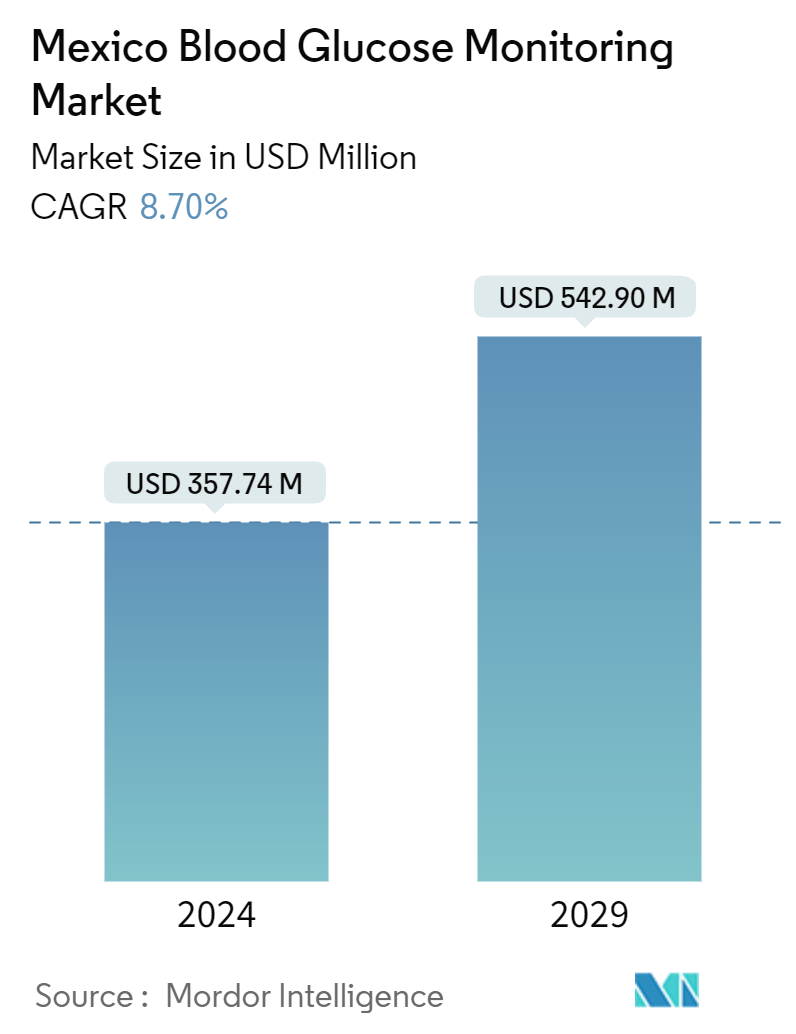
| Study Period | 2019 - 2029 |
| Base Year For Estimation | 2023 |
| Forecast Data Period | 2024 - 2029 |
| Market Size (2024) | USD 357.74 Million |
| Market Size (2029) | USD 542.90 Million |
| CAGR (2024 - 2029) | 8.70 % |
Major Players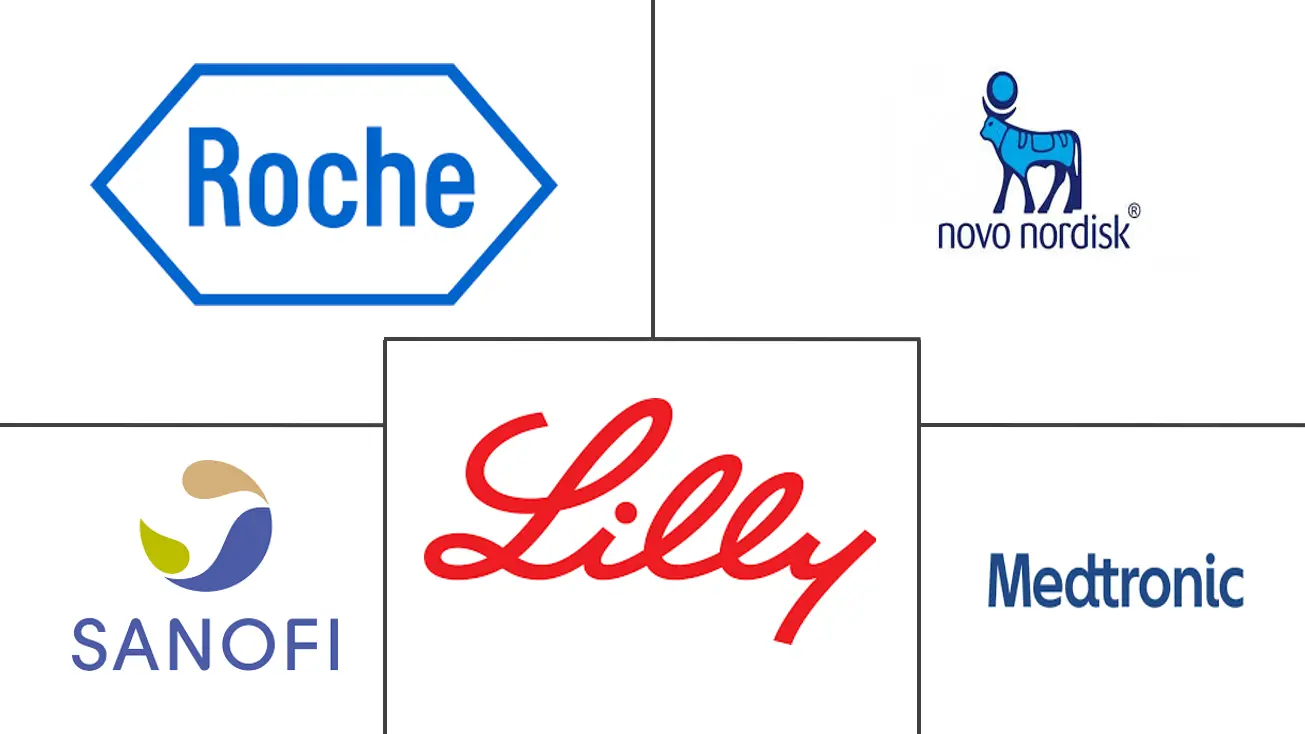
*Disclaimer: Major Players sorted in no particular order |
Mexico Blood Glucose Monitoring Market Analysis
The Mexico Blood Glucose Monitoring Market size is estimated at USD 357.74 million in 2024, and is expected to reach USD 542.90 million by 2029, growing at a CAGR of 8.70% during the forecast period (2024-2029).
Mexico is currently grappling with a major health crisis caused by the increasing prevalence of diabetes among its population. Recent data from the International Diabetes Federation (IDF) reveals that Mexico ranks among the countries with the highest rates of diabetes worldwide. The IDF's findings indicate that an estimated 15.2 million adults between the ages of 20 and 79 in Mexico are affected by diabetes, representing approximately 10.3% of the adult population. This concerning prevalence underscores the critical need for comprehensive strategies to combat the diabetes epidemic in the nation.
Various factors contribute to the elevated rates of diabetes in Mexico. Factors such as rapid urbanization, shifting dietary habits, and sedentary lifestyles have resulted in a rise in obesity rates, a significant risk factor for type 2 diabetes. Additionally, genetic predisposition, socioeconomic inequalities, and limited access to healthcare services further compound the issue, particularly affecting marginalized communities.
As the prevalence of diabetes continues to increase in Mexico, the demand for blood glucose devices is also on the rise. This trend is driving the growth of the blood glucose devices market in the country, as more individuals are in need of monitoring their blood sugar levels regularly.
Overall, the increasing prevalence of diabetes in Mexico is driving the growth of the blood glucose devices market in the country, as more individuals are seeking effective solutions to manage their condition and improve their quality of life. This trend is expected to continue in the coming years, as the healthcare industry focuses on addressing the challenges posed by the rising burden of diabetes in Mexico.
Therefore, owing to the aforementioned factors the studied market is anticipated to witness growth over the analysis period.
Mexico Blood Glucose Monitoring Market Trends
Increasing Type-1 diabetes population across Mexico
According to the IDF Diabetes Atlas 2021, the diabetes prevalence in Mexico has reached 16.9%, or one in every six adults. Diabetes is expected to affect 14 million adults in Mexico by 2021, a 10% increase over the previous two years. Furthermore, 11 million adults in the country have Impaired Glucose Tolerance (IGT), putting them at high risk of developing type 2 diabetes. Mexico's diabetes-related health expenditure has surpassed USD 20 billion, placing it among the top ten countries or territories in terms of total health expenditure. Undiagnosed diabetes affects nearly half of all people with diabetes in the country (47.5%).
Diabetes patients are at risk of serious and life-threatening complications if it is not detected or treated properly, such as heart attack, stroke, kidney failure, blindness, and lower-limb amputation. This leads to a lower quality of life, higher healthcare costs, and a greater need for access to care. Diabetes, particularly Type 2, has become a healthcare burden in Mexico, as it is the leading cause of death among women and the second leading cause of death among men. Obesity, sedentarism, poor eating habits, genetics, family history, and age are all risk factors for diabetes.
Type 1 diabetes (T1D) is frequently overlooked and regarded as a low-prevalence disease in Mexico, where type 2 diabetes (T2D) is highly prevalent, and its incidence and mortality are rising1-4. T1D is one of the most prevalent chronic diseases in children, despite the wide range in incidence and prevalence worldwide5. It has been reported that patients living with T1D (PWT1D) receive suboptimal treatment for several years, increasing their risk of developing long-term complications6. Because of this, patients turn to private endocrinologists for treatment, which raises costs out of pocket.
As a result, the factors above are expected to boost the growth of the Mexican market.
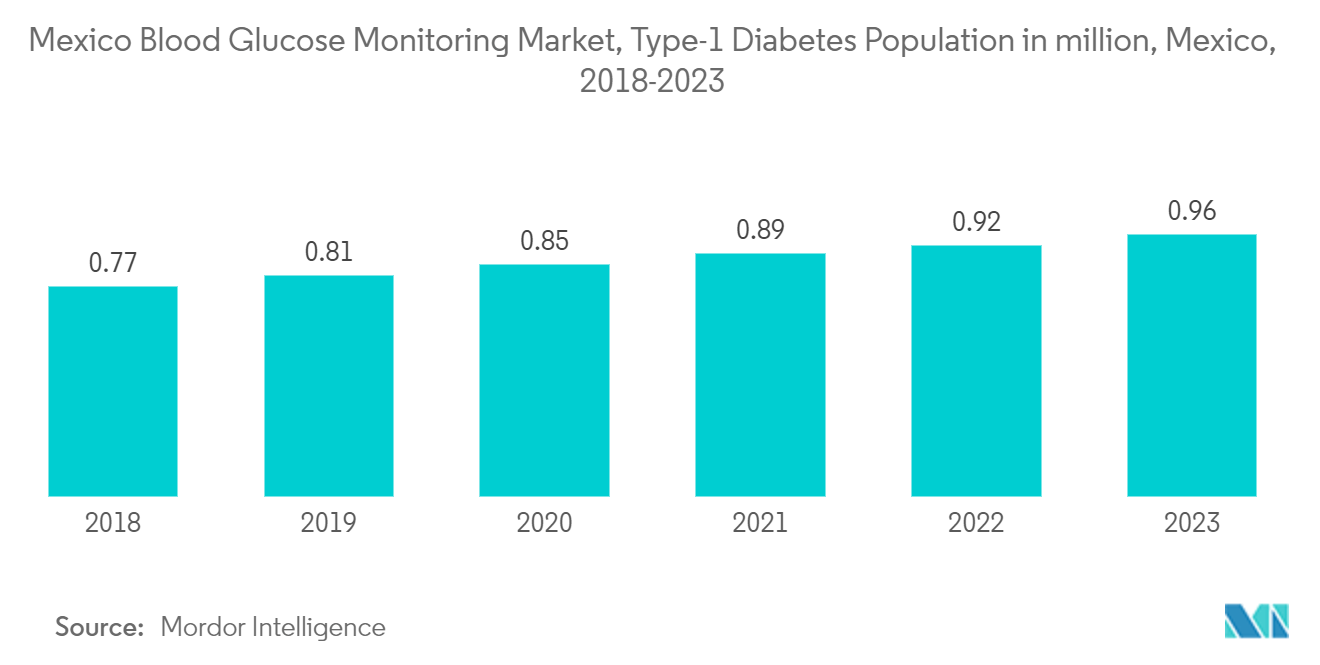
Continuous Glucose Monitoring Holds Highest CAGR in Mexico Blood Glucose Monitoring Market.
Continuous glucose monitoring sensors use glucose oxidase to detect blood sugar levels. Glucose oxidase converts glucose to hydrogen peroxidase, which reacts with the platinum inside the sensor, producing an electrical signal to be communicated to the transmitter. Sensors are the most important part of continuous glucose monitoring devices. Technological advancements to improve the accuracy of the sensors are expected to drive segment growth during the forecast period.
Continuous glucose monitoring sensors use glucose oxidase to detect blood sugar levels. Sensors are the most important part of continuous glucose monitoring devices. Technological advancements to improve the accuracy of the sensors are expected to drive segment growth during the forecast period. According to IDF, the rise in the number of people with type 2 diabetes in Mexico is driven by several socio-economic, demographic, environmental, and genetic factors, including urbanization, decreasing levels of physical activity, and increasing levels of overweight people developing obesity.
The prevalence of diabetes is growing among all ages in Mexico. Diabetes mellitus has been of wide concern with its prevalence, resulting in increased financial burdens for clinical systems, individuals, and governments. Continuous glucose monitoring has become a popular alternative to the portable finger-prick glucometers available in the market for the convenience of diabetic patients. The COVID-19 pandemic emphasizes the need for good glycemic control in patients with diabetes, largely because most observational studies have reported that poorly controlled diabetes is associated with a higher risk of hospitalization and death from a viral illness.
The increased diabetic prevalence in Russia and the above factors will likely drive segment growth during the forecast period.
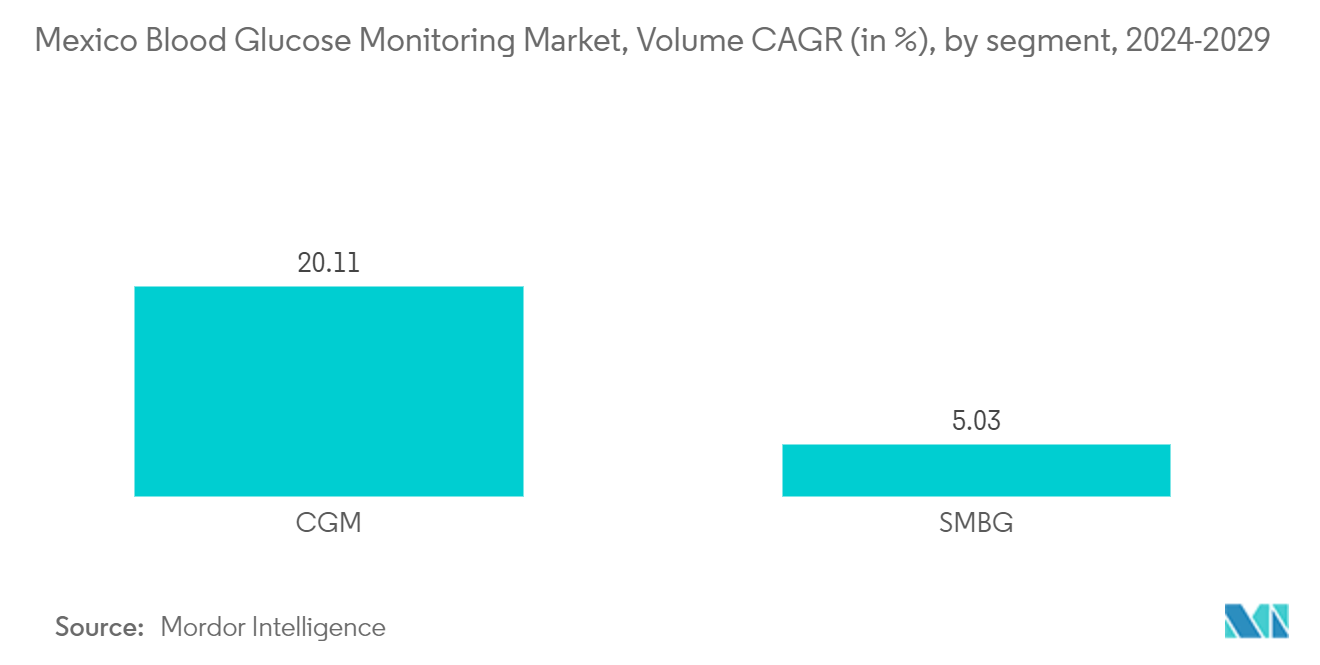
Mexico Blood Glucose Monitoring Industry Overview
The blood glucose monitoring market is highly fragmented, with few major manufacturers present in the market. The CGM devices market is dominated by major players like Dexcom, Medtronics, Abbott, and Senseonics. The market for BGM devices comprises more generic players like Roche, LifeScan, Arkray, Ascensia, etc. Technological innovations in the recent past helped companies to strengthen their market presence.
Mexico Blood Glucose Monitoring Market Leaders
-
Roche
-
Abbott
-
Medtronics
-
Dexcom
-
LifeScan
*Disclaimer: Major Players sorted in no particular order
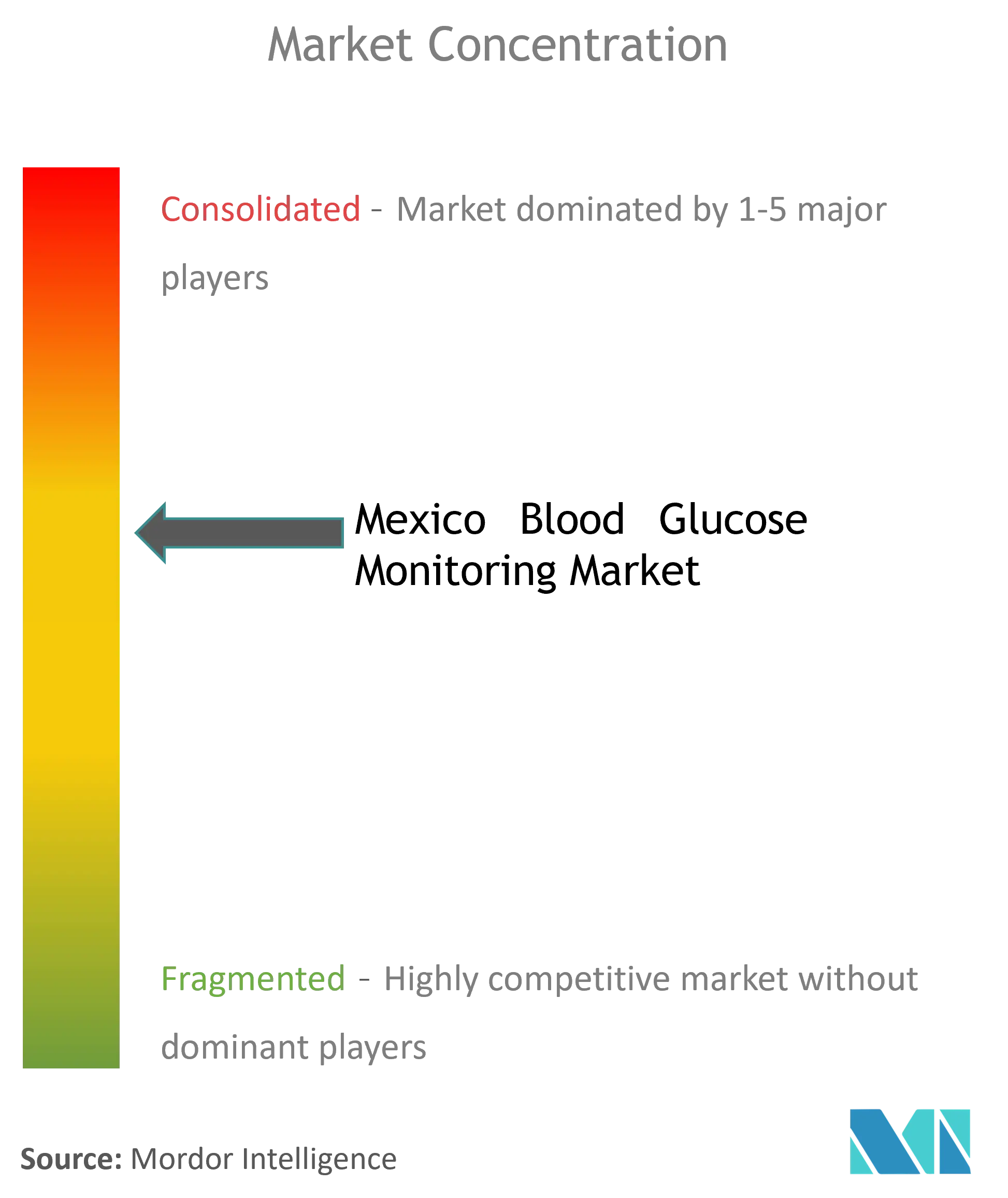
Mexico Blood Glucose Monitoring Market News
- October 2023: Phillips-Medisize, a Molex company, is a prominent player in the pharmaceutical drug delivery, invitro diagnostic, and medtech devices industry. They have partnered with GlucoModicum, an inventive medtech company from Finland, to develop and bring to market an exclusive non-invasive, wearable device that addresses obstacles in continuous glucose monitoring (CGM) for both technology and patient care
- March 2022: DexCom announced the receipt of a CE Mark for its G7 CGM system in Europe, intended for people who have diabetes and are two years and older, including pregnant women. With this approval, the highly popular and best-selling real-time CGM in the world is now more powerful and easier to use with a small, all-in-one wearable and completely redesigned mobile app.
Mexico Blood Glucose Monitoring Market Report - Table of Contents
1. INTRODUCTION
- 1.1 Study Assumptions and Market Definition
- 1.2 Scope of the Study
2. RESEARCH METHODOLOGY
3. EXECUTIVE SUMMARY
4. MARKET DYNAMICS
- 4.1 Market Overview
- 4.2 Drivers
- 4.3 Restraints
-
4.4 Porter's Five Forces Analysis
- 4.4.1 Bargaining Power of Suppliers
- 4.4.2 Bargaining Power of Consumers
- 4.4.3 Threat of New Entrants
- 4.4.4 Threat of Substitute Products and Services
- 4.4.5 Intensity of Competitive Rivalry
5. MARKET SEGMENTATION
-
5.1 Self-monitoring blood glucose devices
- 5.1.1 Glucometer Devices
- 5.1.2 Test Strips
- 5.1.3 Lancets
-
5.2 Continuous blood glucose monitoring devices
- 5.2.1 Sensors
- 5.2.2 Durables (Receivers and Transmitters)
6. MARKET INDICATORS
- 6.1 Type-1 Diabetes population
- 6.2 Type-2 Diabetes population
7. COMPETITIVE LANDSCAPE
-
7.1 COMPANY PROFILES
- 7.1.1 Abbott Diabetes Care
- 7.1.2 Roche Holding AG
- 7.1.3 LifeScan
- 7.1.4 Dexcom Inc.
- 7.1.5 Medtronic PLC
- 7.1.6 Arkray Inc.
- 7.1.7 Ascensia Diabetes Care
- 7.1.8 Agamatrix Inc.
- 7.1.9 Bionime Corporation
- 7.1.10 Acon Laboratories Inc.
- 7.1.11 Trivida Functional Medicine
- 7.1.12 Senseonics
- *List Not Exhaustive
-
7.2 COMPANY SHARE ANALYSIS
- 7.2.1 Self-monitoring Blood Glucose Devices
- 7.2.1.1 Abbott Diabetes Care
- 7.2.1.2 Roche Holding AG
- 7.2.1.3 LifeScan
- 7.2.2 Continuous Glucose Monitoring Devices
- 7.2.2.1 Dexcom Inc.
- 7.2.2.2 Medtronic PLC
- 7.2.2.3 Abbott Diabetes Care
8. MARKET OPPORTUNITIES AND FUTURE TRENDS
** Subject To AvailablityMexico Blood Glucose Monitoring Industry Segmentation
A blood glucose monitoring device consists of a handheld meter and disposable test strips. The user pricks their finger with a lancet to draw a small drop of blood, which is then applied to the test strip. The meter analyzes the blood sample and displays the glucose concentration in milligrams per deciliter (mg/dL) or millimoles per liter (mmol/L) on a digital screen. Mexico Blood Glucose Monitoring Market is segmented into Type and component. The report offers the value (in USD) and volume (in Units) for the above segments.
| Self-monitoring blood glucose devices | Glucometer Devices |
| Test Strips | |
| Lancets | |
| Continuous blood glucose monitoring devices | Sensors |
| Durables (Receivers and Transmitters) |
Mexico Blood Glucose Monitoring Market Research FAQs
How big is the Mexico Blood Glucose Monitoring Market?
The Mexico Blood Glucose Monitoring Market size is expected to reach USD 357.74 million in 2024 and grow at a CAGR of 8.70% to reach USD 542.90 million by 2029.
What is the current Mexico Blood Glucose Monitoring Market size?
In 2024, the Mexico Blood Glucose Monitoring Market size is expected to reach USD 357.74 million.
Who are the key players in Mexico Blood Glucose Monitoring Market?
Roche, Abbott, Medtronics, Dexcom and LifeScan are the major companies operating in the Mexico Blood Glucose Monitoring Market.
What years does this Mexico Blood Glucose Monitoring Market cover, and what was the market size in 2023?
In 2023, the Mexico Blood Glucose Monitoring Market size was estimated at USD 326.62 million. The report covers the Mexico Blood Glucose Monitoring Market historical market size for years: 2019, 2020, 2021, 2022 and 2023. The report also forecasts the Mexico Blood Glucose Monitoring Market size for years: 2024, 2025, 2026, 2027, 2028 and 2029.
Mexico Blood Glucose Monitoring Industry Report
Statistics for the 2024 Mexico Blood Glucose Monitoring market share, size and revenue growth rate, created by Mordor Intelligence™ Industry Reports. Mexico Blood Glucose Monitoring analysis includes a market forecast outlook 2029 and historical overview. Get a sample of this industry analysis as a free report PDF download.



